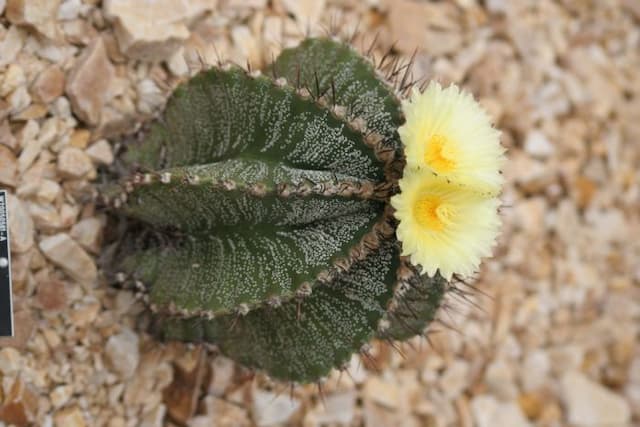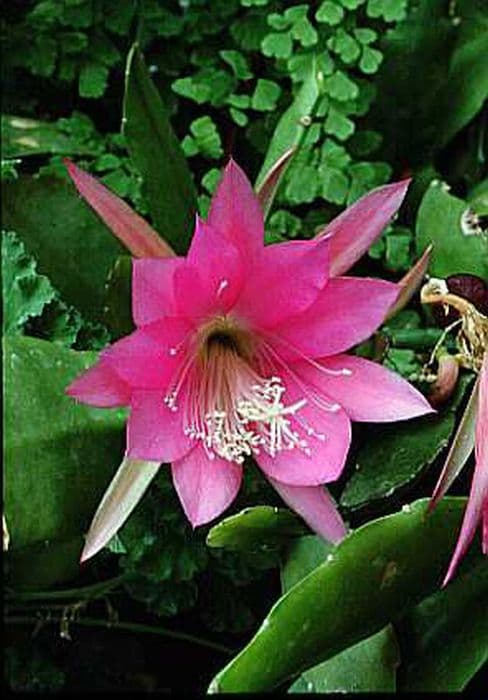Mammillaria prolifera

ABOUT
Commonly known as the Texas nipple cactus, this plant is characterized by its globular to elongated shape. It sports numerous small, green, fleshy stems which are heavily clustered together. The surface of the stems is adorned with tiny bumps known as tubercles. These tubercles are arranged in a spiral pattern and give the cactus a textured appearance. Tiny spines emerge from the tubercles, but rather than being sharp and imposing, they are fine and hair-like, often appearing white or yellowish. The Texas nipple cactus readily produces offsets at the base and upper parts of the stems, which can lead to clumping over time – a feature that contributes to its proliferous nature. During the blooming season, the plant displays a ring of small, trumpet-shaped flowers that wrap around the crown of the stems. The flowers are typically yellow, sometimes with a red or green tint, adding a splash of color to the green cactus. Completing its ornamentation, small, club-shaped fruits may appear after the flowers, starting green and turning red as they mature. These fruits offer a stark contrast to the green of the stems and the blooms, making the cactus more visually striking. With its cluster of stems, delicate spines, bright flowers, and attractive fruits, the Texas nipple cactus presents itself as a charming and subtly complex plant to onlookers.
About this plant
 Names
NamesSynonyms
Texas Nipple Cactus, Pineapple Cactus, Texas Tuber Cactus
Common names
Cactus prolificus, Chilita prolifera, Mammillaria fragilis, Neomammillaria prolifera, Cactus mammillaris, Mammillaria gracilis.
 Toxicity
ToxicityTo humans
The Texas nipple cactus (Mammillaria prolifera) is not known to be toxic to humans. Therefore, if ingested, it is unlikely to cause poisoning or serious side effects. However, the spines on cacti can cause physical injury if not handled properly.
To pets
Similar to humans, the Texas nipple cactus is not known to be toxic to pets. Ingesting this plant should not cause serious health issues, but as with humans, the spines can cause physical injury, and pets attempting to eat or play with the plant may end up with irritation or injury from the spines.
 Characteristics
CharacteristicsLife cycle
Perennials
Foliage type
Evergreen
Color of leaves
Green
Flower color
Cream
Height
6 inches (15 cm)
Spread
12 inches (30 cm)
Plant type
Cactus
Hardiness zones
9
Native area
Mexico
Benefits
 General Benefits
General Benefits- Easy to Grow: Mammillaria prolifera, commonly known as the Texas nipple cactus, is a low-maintenance plant that is easy to care for, making it ideal for novice gardeners.
- Drought Tolerant: This species is highly resistant to drought, making it suitable for xeriscaping and saving water in arid climates.
- Aesthetic Appeal: The Texas nipple cactus adds a unique visual interest to any garden or collection with its small, clustered globular stems and rings of white flowers.
- Habitat for Wildlife: The flowers attract pollinators like bees and hummingbirds, providing them with nectar and contributing to the ecosystem's biodiversity.
- Educational Interest: Cacti, including Mammillaria prolifera, are often used in educational settings to teach about adaptation, desert plant life, and the importance of conservation.
- Culinary Use: The fruit of the Texas nipple cactus, while not commonly consumed, can be edible and used in making candies or jellies in some traditional practices.
- Ornamental Uses: Due to its compact size and distinctive look, it's commonly used in rock gardens, terrariums, and as a potted feature on balconies and patios.
- Soil Erosion Control: The root systems of cacti like Mammillaria prolifera can help to stabilize soil and prevent erosion in certain environments.
 Medical Properties
Medical PropertiesThis plant is not used for medical purposes.
 Air-purifying Qualities
Air-purifying QualitiesThis plant is not specifically known for air purifying qualities.
 Other Uses
Other Uses- Mammillaria prolifera, commonly known as the Texas nipple cactus, can be used in miniature gardening and fairy gardens due to its small size and interesting texture.
- This plant is suitable for growing in terrariums with other small, drought-tolerant plants to create a desert-themed miniature ecosystem.
- The Texas nipple cactus can be used in educational settings to teach students about succulent propagation, as it readily produces offsets.
- These cacti are sometimes incorporated into living walls or vertical gardens, bringing a unique three-dimensional element to the design.
- Hobbyists and crafters use this cactus in creating living art pieces, such as planting them in unusual or upcycled containers.
- Due to its interesting appearance, Mammillaria prolifera can be used as a natural decoration during festive seasons, especially in Southwestern themed decor.
- Artists and photographers may utilize the Texas nipple cactus as a subject or backdrop in still life photography, to add texture and character to their compositions.
- This cactus can be gifted as a symbol of resilience and toughness, making it a suitable desk plant for offices or personal workspaces.
- The plant can be used in xeriscaping, a landscaping method that reduces or eliminates the need for irrigation, thereby conserving water.
- Mammillaria prolifera can act as a natural source of food and protection for certain desert insects, thus playing a role in creating a habitat garden.
Interesting Facts
 Feng Shui
Feng ShuiThe Texas nipple cactus is not used in Feng Shui practice.
 Zodiac Sign Compitability
Zodiac Sign CompitabilityThe Texas nipple cactus is not used in astrology practice.
 Plant Symbolism
Plant Symbolism- Resilience: Mammillaria prolifera, also known as the Texas nipple cactus, is able to thrive in arid environments with minimal water, symbolizing the ability to endure and persist through challenging conditions.
- Protection: With its sharp spines, this cactus represents a form of natural self-defense, embodying the concept of setting boundaries and safeguarding oneself from external threats.
- Adaptability: As a plant that can adapt to extreme climates, the Texas nipple cactus is often associated with flexibility and the ability to adjust to various situations in life.
- Independence: Due to its self-sufficient nature, needing very little to survive, it symbolizes autonomy and the ability to thrive with limited resources.
 Water
WaterThe Texas nipple cactus should be watered when the soil has dried out completely, typically every 1 to 2 weeks during the active growing season in spring and summer. Reduce watering to once a month during the dormant winter period. When watering, soak the soil thoroughly until water runs out of the drainage holes, which might require around 8 to 16 ounces for a small to medium-sized pot. It's crucial to avoid letting the plant sit in standing water as this can lead to root rot.
 Light
LightThe Texas nipple cactus thrives best in bright, indirect sunlight, such as that found near a south-facing or east-facing window where direct sunlight is filtered or limited to a few hours a day. It can also tolerate direct morning sunlight but should be protected from the harsh afternoon sun that can scorch its delicate spines and skin.
 Temperature
TemperatureThe Texas nipple cactus prefers average room temperatures between 70 and 80 degrees Fahrenheit but can survive in temperatures as low as 40 degrees Fahrenheit and as high as 90 degrees Fahrenheit. Be sure to protect the cactus from frost and drastically fluctuating temperatures for optimal health.
 Pruning
PruningPruning is generally not required for the Texas nipple cactus, as it maintains a compact shape on its own. If necessary to remove damaged or dead parts, do so using sterile, sharp tools, ideally during the growing season when the plant heals faster.
 Cleaning
CleaningAs needed
 Soil
SoilThe Texas Nipple Cactus prefers a well-draining soil mix with equal parts of potting soil, coarse sand, and perlite or pumice. The ideal pH for this cactus is slightly acidic to neutral, around 5.5 to 7.0.
 Repotting
RepottingThe Texas Nipple Cactus should be repotted every two to three years or when it has outgrown its pot to prevent root crowding and to replenish its soil nutrients.
 Humidity & Misting
Humidity & MistingThe Texas Nipple Cactus thrives best in low to moderate humidity conditions. It is well-suited for typical indoor humidity levels, avoiding overly humid environments.
 Suitable locations
Suitable locationsIndoor
Place Texas Nipple Cactus in bright, indirect light, and avoid overwatering.
Outdoor
Grow in full sun to partial shade and protect from excessive rain.
Hardiness zone
9-11 USDA
 Life cycle
Life cycleMammillaria prolifera, commonly known as the Texas Nipple Cactus, begins its life cycle as a seed, which germinates in well-draining soil and warm temperatures typical of its native habitat. After germination, it enters the seedling stage, where it starts to develop its characteristic spiny, globular shape, though at a much smaller scale. As the cactus matures, it grows in size and may produce offsets, or "pups," around its base, contributing to its proliferative nature. Flowering occurs periodically in the mature plant, usually in spring or summer, producing small, pale yellow to greenish flowers, followed by small red fruits that contain seeds, thereby enabling sexual reproduction. The Texas Nipple Cactus has a relatively long lifespan, with individuals continuously growing, flowering, and producing fruits for many years, often surviving for several decades in the right conditions. Throughout its life, the cactus requires minimal water, bright light, and protection from frost to thrive and progress through its life stages.
 Propogation
PropogationPropogation time
Spring-Early Summer
The Texas nipple cactus, Mammillaria prolifera, is popularly propagated through offsets, which are small cacti that grow from the base of the parent plant. The best time to propagate this cactus is during the warmer months of spring and summer when the plant is actively growing. To propagate by offsets, gently twist off one of the offsets from the mother plant, making sure to get a clean separation. Allow the offset to dry for a couple of days until the cut end forms a callus, which prevents infection. After the callus has formed, plant the offset in a pot filled with a well-draining cactus mix. Water the soil lightly just to moisten it, using about a quarter cup (approximately 59 milliliters) of water; be careful not to overwater. With proper care, the offset will root and eventually grow into a new cactus.









